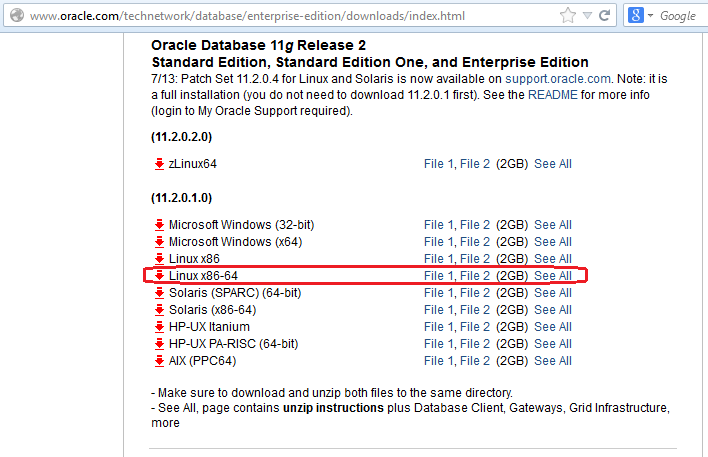

- #Install oracle 11g enterprise edition on ubuntu install
- #Install oracle 11g enterprise edition on ubuntu update
- #Install oracle 11g enterprise edition on ubuntu manual
- #Install oracle 11g enterprise edition on ubuntu software
- #Install oracle 11g enterprise edition on ubuntu code
"sqlplus: error while loading shared libraries: libclntsh.so.11.1" : The prerequisites have not been met. You may also get this error is the "/etc/hosts" file is not configured correctly.
#Install oracle 11g enterprise edition on ubuntu code
"error code 37" : The DNS not working properly. If you are using DNS for name resolution, you still need the loopback adapter reference in this file. It needs an entry for the loopback adapter (localhost) and the machine name. "error code 35" : The machine name in the "/etc/hosts" file is not correct. You can see the type of installation I performed by clicking on the links below to see screen shots of each stage.Įdit the "/etc/oratab" file setting the restart flag for each instance to 'Y'.ĭB11G:/u01/app/oracle/product/11.2.0/db_1:Y Common Errors Proceed with the installation of your choice. Start the Oracle Universal Installer (OUI) by issuing the following command in the database directory. If you are using X emulation then set the DISPLAY environmental variable. LD_LIBRARY_PATH=$ORACLE_HOME/lib:/lib:/usr/lib export LD_LIBRARY_PATHĬLASSPATH=$ORACLE_HOME/jlib:$ORACLE_HOME/rdbms/jlib export CLASSPATH Installation ORACLE_HOME=$ORACLE_BASE/product/11.2.0/db_1 export ORACLE_HOME ORACLE_BASE=/u01/app/oracle export ORACLE_BASE ORACLE_UNQNAME=DB11G export ORACLE_UNQNAME ORACLE_HOSTNAME=ol5-112.localdomain export ORACLE_HOSTNAME

Login as the oracle user and add the following lines at the end of the ".bash_profile" file, remembering to adjust them for your specific installation. Login as root and issue the following command.
#Install oracle 11g enterprise edition on ubuntu software
If you have the Linux firewall enabled, you will need to disable or configure it, as shown here or here.Ĭreate the directories in which the Oracle software will be installed. If SELinux is disabled after installation, the server will need a reboot for the change to take effect. Click on the SELinux tab and disable the feature. Set secure Linux to permissive by editing the "/etc/selinux/config" file, making sure the SELINUX flag is set as follows.Īlternatively, this alteration can be done using the GUI tool (Applications > System Settings > Security Level). The following setup tasks must be performed regardless of which setup method you used previously. We are not going to use the "asmadmin" group, since this installation will not use ASM. Useradd -g oinstall -G dba,oper,asmadmin oracle
#Install oracle 11g enterprise edition on ubuntu install
Install the following packages if they are not already present. Run the following command to change the current kernel parameters.Īdd the following lines to the "/etc/security/nf" file. # semaphores: semmsl, semmns, semopm, semmni The current values can be tested using the following command.Īdd or amend the following lines in the "/etc/nf" file. Oracle recommend the following minimum parameter settings. If you have not used the "oracle-validated" package to perform all prerequisites, you will need to manually perform the following setup tasks.
#Install oracle 11g enterprise edition on ubuntu update
It is probably worth doing a full update as well, but this is not strictly speaking necessary.

If you plan to use the "oracle-validated" package to perform all your prerequisite setup, follow the instructions at to setup the yum repository for OL, then perform the following command.Īll necessary prerequisites will be performed automatically. The Additional Setup is required for all installations.
#Install oracle 11g enterprise edition on ubuntu manual
Perform either the Automatic Setup or the Manual Setup to complete the basic prerequisites. The "/etc/hosts" file must contain a fully qualified name for the server.ġ27.0.0.1 localhost.localdomain localhostġ92.168.2.181 ol5-11gr2.localdomain ol5-11gr2 Oracle Installation Prerequisites You should now have a single directory called "database" containing installation files. OTN: Oracle Database 11g Release 2 (11.2.0.1) Software (64-bit).Alternative installations may require more packages to be loaded, in addition to the ones listed below.ĭownload the Oracle software from OTN or MOS depending on your support status. Desktop Environments > GNOME Desktop EnvironmentĪn example of this type of Linux installations can be seen here.Oracle recommend a default server installation, but for these installations the following package groups installed: The article is based on a server installation with a minimum of 2G swap and secure Linux set to permissive. This article describes the installation of Oracle Database 11g Release 2 (11.2) (64-bit) on Oracle Linux 5 (64-bit). Home » Articles » 11g » Here Oracle Database 11g Release 2 (11.2) Installation On Oracle Linux 5.0


 0 kommentar(er)
0 kommentar(er)
